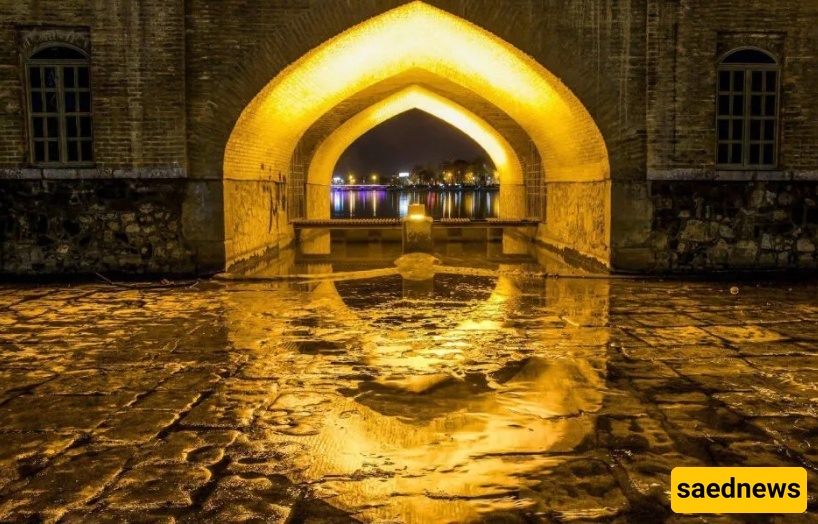SAEDNEWS: The Si-o-se Pol Bridge in Isfahan is one of the most famous historical landmarks, spanning the Zayandeh Rud River and distinguished by its unique design featuring 33 arches. It is considered a symbol of Safavid architecture and an integral part of the city’s cultural life.
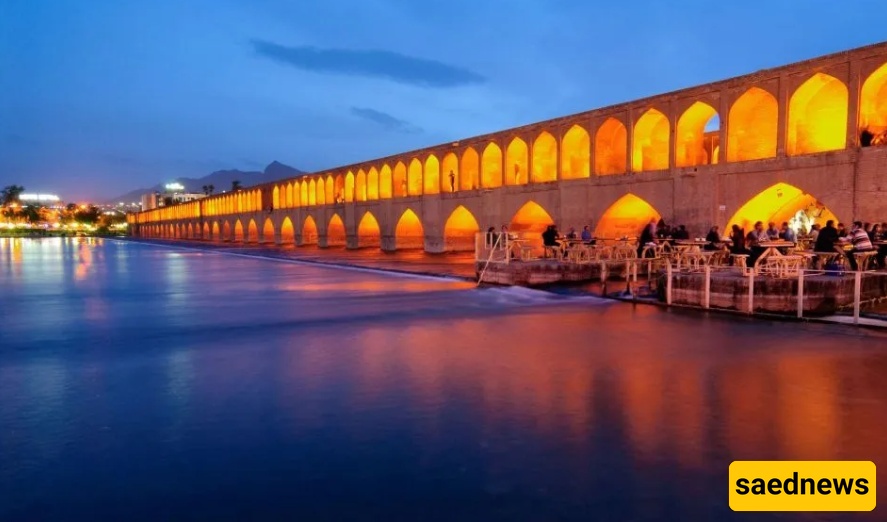
In the heart of Isfahan city, along the banks of the Zayandeh Rud River, stand bridges, each telling a story from the depths of history. One of these is the Thirty-Three Bridge, a surviving relic from the Safavid era and an architectural masterpiece in Iran. For more than 400 years, this bridge has showcased its beauty and stood firmly in its place. It is known as the longest bridge over the Zayandeh Rud River.
This valuable monument was registered on January 5, 1932, under number 110 on the list of Iran’s national heritage sites, and it remains one of the most famous tourist attractions in the country.
Stay tuned to learn more about the history and design of this historic bridge.

The strong structure of the Thirty-Three Bridge was built by Allahverdi Khan Undiladze, the famous Georgian commander during the reign of Shah Abbas. Some Georgians believe that the number of the bridge’s thirty-three arches is related to the number of letters in the Georgian alphabet, which totals 33 letters, due to Allahverdi Khan’s Georgian origins. However, this theory was completely rejected because the bridge originally had 40 arches. On the other hand, experts believe that the number 33 is linked to the goddess Anahita (the goddess of water), and that this bridge, like most water constructions and bridges, is considered a symbol of Anahita.
During Shah Abbas’s reign, the main urban plan of Isfahan city was “Chaharbagh,” consisting of two perpendicular axes. The Thirty-Three Bridge was placed along one of these main axes to connect Chaharbagh Abbasi, Chaharbagh Bala, Bagh Hezarjarib, Abbas Abad, and the Jolfa district. At that time, the bridge had 40 arches, but over time, due to tree planting and the diversion of water flow, some arches became abandoned. In the year 1330 AH (1911-1912 AD), Mostafa Khan Mostofi, mayor of Isfahan, cleared the lands around the bridge, reopened the water channel, and built a stone wall on the northern side of the bridge, the remains of which are still visible today.
Different sources record different years for the bridge’s construction, but for a more accurate review, some historical facts must be examined. All evidence indicates that the bridge existed by 1018 AH (1609-1610 AD), during the “Golrizan” celebrations attended by Shah Abbas. However, when reviewing earlier years and archives, the completion year of the bridge varies among sources.
For example, Eskandar Beg Turkoman, the writer and editor of the book “Alam Ara-ye Abbasi” about the Safavid era, describes this bridge in the year 1011 AH (1602-1603 AD):
“At the end of the street, a large, multi-layered garden was created to serve the king, named Abbas Abad Garden, and a great bridge consisting of forty arches was built, wide enough to appear as a single arch during the water flood, connecting the streets across the Zayandeh Rud River.”
Haj Mirza Hassan Khan Jaberi Ansari, historian and writer in Isfahan, mentions the city in parts of the events of 1005 AH (1596-1597 AD):
“Shah Abbas made Isfahan his permanent capital, began constructing great buildings, Qeysarieh Gate, and waged war against the Uzbeks.”
In the events of 1008 AH (1599-1600 AD), he wrote:
“The Shah returned from Herat to Isfahan and completed the buildings and gardens built by princes around the old Chaharbagh and Chaharbagh Bala.”
He adds:
“Shah Abbas returned to Isfahan and ordered Allahverdi Khan to build a bridge over the Zayandeh Rud River along with administrative buildings.”
In the events of 1012 AH (1603-1604 AD), it is described:
“The construction of the ornate Qeysarieh Gate with distinguished tiles…”
The poet Mirza Ali Naqi Kamreh Ai, from the poets of Shah Abbas’s era, composed verses saying:
“The fate of Allahverdi Khan and the destiny of Shah Abbas in times will be attained.
In the morning, Beg Verdi Dadgar began the bridge’s construction to be completed in the best condition.
By the king’s effort and with Agha Hossein’s direction, the work was completed with excellence and beauty.
With the hard hand of Amir Zabr, the construction was called Amir’s Bridge.
After years, no one found the bridge’s history more beautiful than the completion date.”
It can be said, based on the book “Alam Ara,” that the bridge was built in 1011 AH, but Jaberi Ansari’s accounts differ; he refers partly to the bridge being built that year, and elsewhere considers that year as the order date for construction. He also mentions that the bridge was built simultaneously with Qeysarieh Gate, while the events of 1012 AH refer to the gate’s construction.
According to the verses of Naqi Kamreh Ai, Amir’s Bridge was built in 1005 AH, but its starting date is unclear. If this refers to the Thirty-Three Bridge, its construction must have begun at least in 1003 AH and been completed in 1005 AH.
It is important to note here that since buildings were constructed on one side of the Zayandeh Rud River, a bridge was necessary to connect both sides at that time, and this construction also dates back to 1005 AH according to documents.
As for Allahverdi Khan, who was assigned to build the bridge, he was appointed governor of Fars province in 1004 AH by Shah Abbas I, managing its affairs and later ruling Kohgiluyeh. Historical documents indicate that after Shah Abbas took power, he wanted to make Isfahan his permanent capital, issuing orders for construction and development. Allahverdi Khan’s appointment in Fars was part of these orders to oversee Isfahan’s development, meaning the city’s construction took place after 1004 AH.
A historical document indicates that the construction of Allahverdi Khan’s Bridge and the development of Chaharbagh Street ended in 1005 AH, the Chaharbagh Tekiyas (religious lodges) were built in 1011 AH, and all the buildings initiated by Shah Abbas were completed by 1025 AH.
A question arises here: Why do some sources state that Allahverdi Khan was assigned to build the bridge in 1011 AH while the completion date is 1005 AH? It can be said that Allahverdi Khan completed the lower layer of the bridge in 1005 AH, and in 1011 AH he was assigned to complete the upper layer to prevent disruption of traffic during the river’s flood. Perhaps the flooding of the Zayandeh Rud was the reason behind this decision, settling the debate.
On the other hand, it is possible that the bridge referred to by Kamreh Ai was in Fars, but since no similar bridge is mentioned in history, it must be that the Thirty-Three Bridge is the one meant.
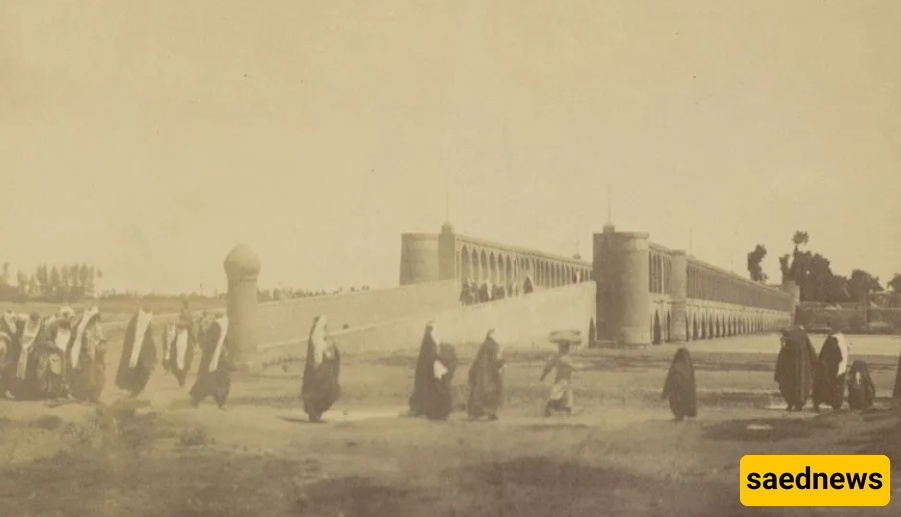
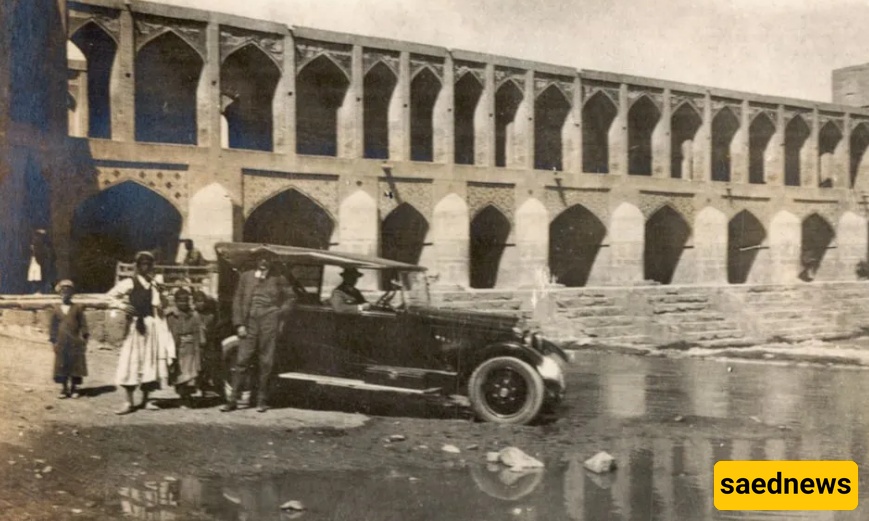

British General Percy Sykes described the Thirty-Three Bridges as one of the world’s first-class bridges, while French traveler Jean Chardin regarded it as an astonishing architectural masterpiece.
Don García, the Spanish king’s ambassador at the court of Shah Abbas the Safavid, mentioned this bridge as one of the finest architectural works in Iran, writing:
"This bridge is also one of the constructions by Allahverdi Khan Undiladze, the Georgian. Although his enemies and jealous rivals claim that this building was funded with money, they cannot deny that he was the builder. However, the common belief, which is also the truth, is that Allahverdi Khan financed the bridge with his own money."
Lord George Nathaniel Curzon — the British politician and Iran expert — commented:
“One would not expect to have to travel to Iran to see what can unquestionably be called the greatest bridge in the world.”
A drawing of the Thirty-Three Bridges dating back to the 17th century was made by Jean Chardin.

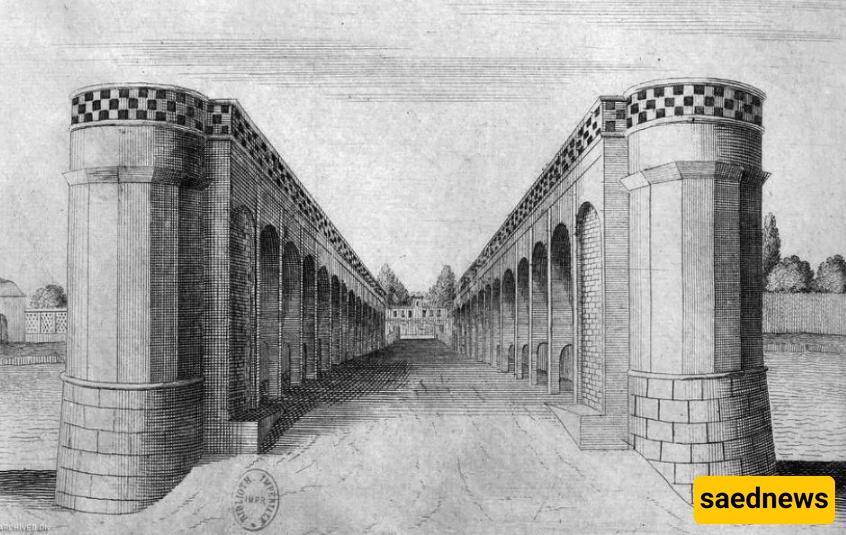
What we know today as the Thirty-Three Bridges has carried different names throughout history:
Shah Abbas Bridge, named after Shah Abbas who ordered its construction.
Allahverdi Khan Bridge, named after Allahverdi Khan who exerted great effort in building the bridge.
Jolfa Bridge, due to its location as a crossing point for the people of Jolfa (a district in Isfahan).
The Forty-Arches Bridge, because originally it contained forty arches.
The Thirty-Three Arches Bridge, since only thirty-three arches remain, which gave rise to its current name.
Zayandeh Rud Bridge, as it is the longest bridge over the Zayandeh Rud River.
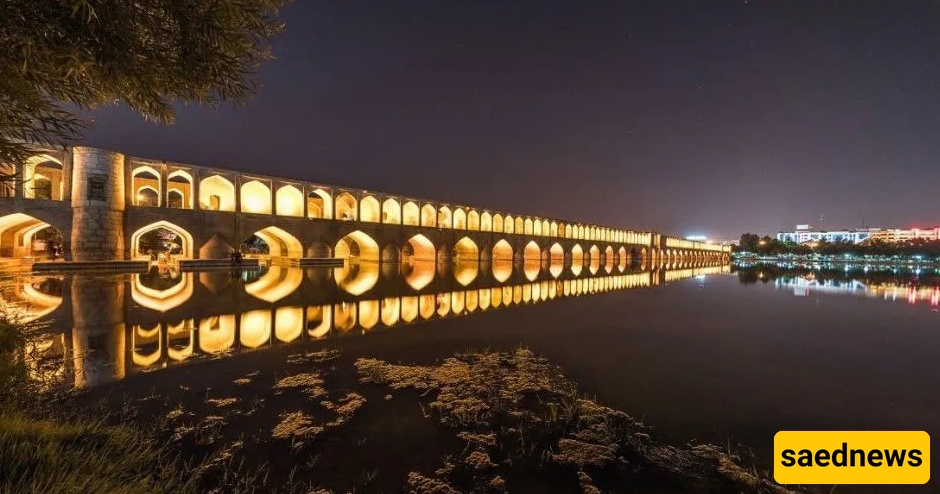
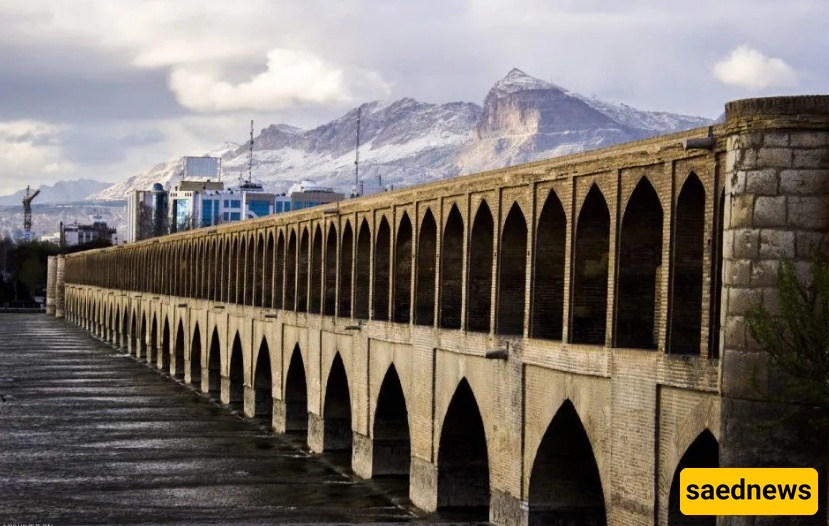
During the Safavid era, the Thirty-Three Bridges served as a site for various celebrations. Here are some notable examples:
The Water Sprinkling Festival: European travelers documented a celebration held annually on the 13th of Tir (June–July) near the Thirty-Three Bridges. The event was attended by the king, nobles, poets, politicians, and city residents. Known as the "Water Sprinkling Festival" or "Abrizgan," participants joyfully sprinkled and scented water on each other to celebrate.
The Washing of Christ Ceremony: Known as "Khaj-shoyan," this Christian festival commemorates the baptism of Jesus Christ. Christians believe that the water on this day is sacred, entering flowing waters to immerse themselves. During the Safavid period, Armenians in Iran held this celebration on January 13 (24 Dey) beside the Thirty-Three Bridges in Isfahan. Interestingly, Armenians at that time had the right to be present in the square near the bridge’s entrance and engage in trade with Isfahan’s residents but were not permitted to cross the bridge.
Nowruz (Persian New Year): In the Safavid era, Nowruz celebrations lasted between three to seven days, during which the Thirty-Three Bridges were illuminated with decorative lights. Occasionally, Shah Abbas ordered a rose petal shower to be performed on the bridge, sprinkling flowers on the path of the king and his entourage. In the year 1018 AH (1609–1610 AD), although Nowruz coincided with the month of Muharram, the king commanded a seven-day celebration including the rose-petal ceremony on the bridge. Thanks to the skill of Isfahan’s residents in decorating the city and the bridge, the king granted them a tax reward of 500 tomans that year.
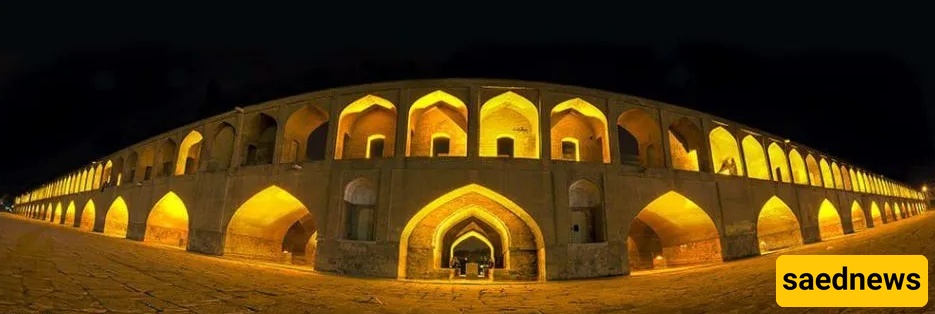
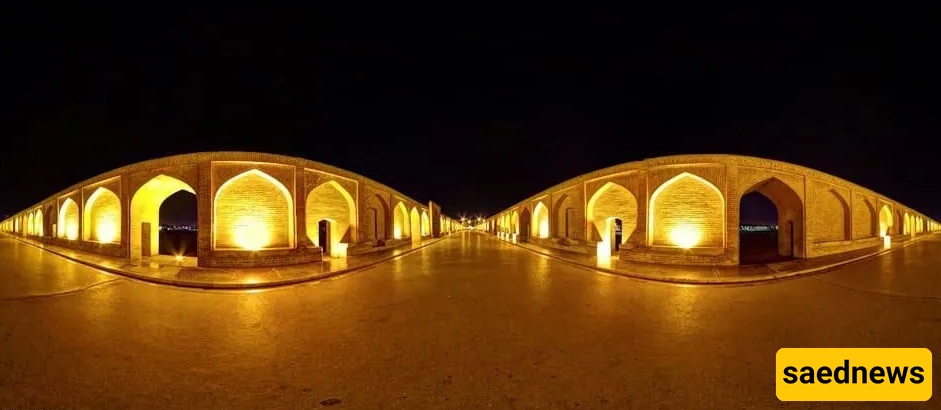
The engineer behind the Thirty-Three Arches Bridge was Master Hossein Banna Isfahani, whose son, Mohammad Reza Isfahani, is renowned for architectural masterpieces such as Sheikh Lotfollah Mosque. Contrary to the usual practice of building bridges in narrow locations, Hossein chose the widest part of the Zayandeh Rud River for this bridge because this section is characterized by its shallow, wide, and calm waters, overlooking a stunning natural landscape.
Three main materials were used in the construction of the Thirty-Three Arches Bridge: stone for the lower parts, and bricks combined with Sarooj mortar and plaster for the upper parts. Sarooj is an ancient Iranian architectural innovation composed of clay, lime, ash, and specific fibrous materials (including certain seeds and cane fibers) and manufactured through specialized processes.
According to geologists and cultural heritage experts, the bridge’s foundations were built using a method that enhances its resistance to moisture, ensuring its durability and stability. For this reason, the water has caused no damage to the bridge over a long period.
Sir Percy Molesworth Sykes, a British general, writer, and geographer, described the Thirty-Three Arches Bridge and its condition in the late 13th and early 14th centuries AH (19th–20th centuries AD). He noted that access to the bridge’s entrance was via a stone-paved road, and the bridge contained three passageways on three different levels.
On both sides of the bridge are covered arches overlooking the river on one side and the middle of the bridge on the other, creating a narrow covered corridor along the sides. The bridge’s walkway housed 99 alcoves where artworks were once displayed, though these no longer exist today. At the bridge’s front stood a statue of Reza Shah mounted on a 5-meter-high column riding a horse, but no trace of it remains now.
The arches rest on columns ranging in height from 7 to 9 meters, which support the roof and give the structure a very grand and sturdy appearance.
Originally, the bridge was 360 meters long with 40 large arches. Today, it contains 33 arches, with a width of 14 meters and a length of 295 meters, making it the longest bridge on the Zayandeh Rud River. The bridge formerly had six passageways as follows:
The central road designated for carriages and automobiles.
2 & 3. The two sides of the bridge, featuring beautiful halls for pedestrians.
4 & 5. The roofs of the halls on both sides, surrounded by railings, which turned into a luxurious promenade during the Zayandeh Rud floods.
Lastly, stairs connected the bridge halls to the riverbank below, which were used by pedestrians during periods of low water levels.
Today, only two pedestrian pathways remain: one open-air on top and the other covered beneath, positioned between the central columns and close to the riverbed.
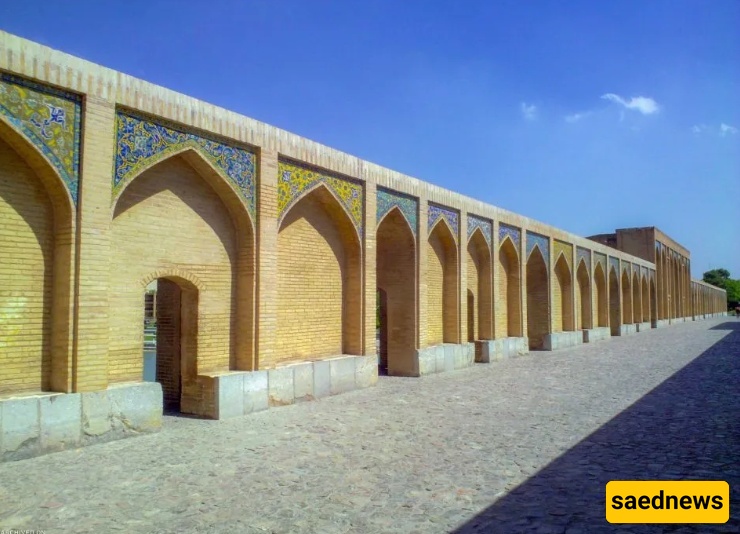
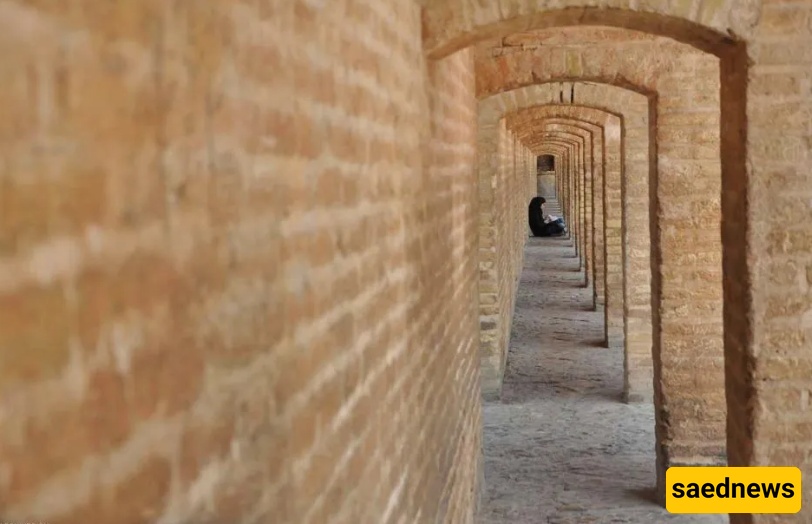
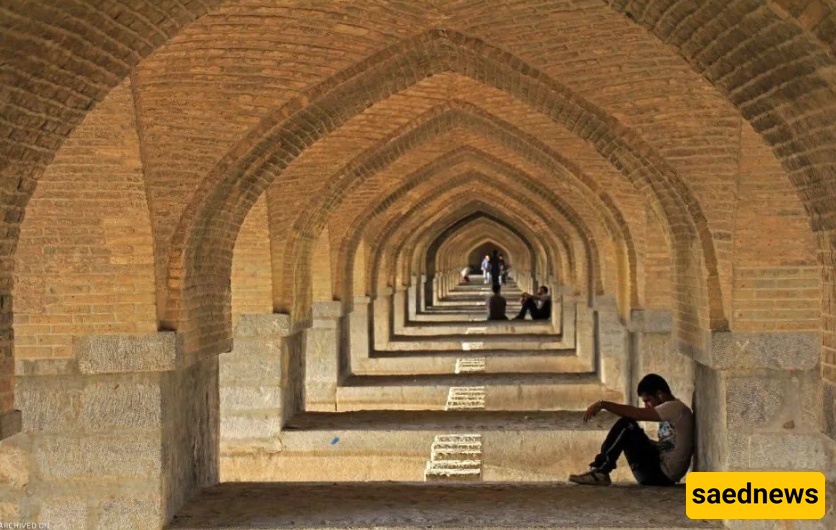

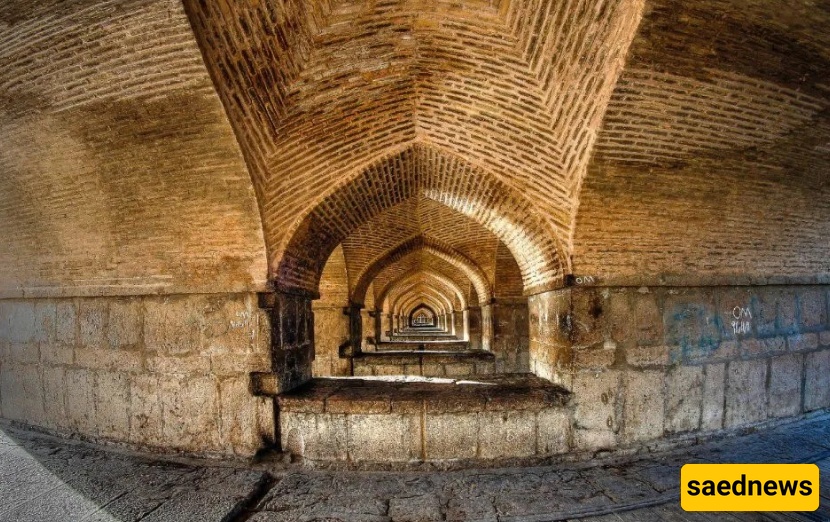
The Thirty-Three Arches Bridge is more than just a historic structure you occasionally visit to take a stroll back in time. This bridge still shines like a precious gem in the crown of Isfahan and holds immense value for the people. Visiting the site near sunset is enough to enjoy a walk across the bridge while witnessing the enchanting view of the setting sun and becoming part of the joyful crowd that gathers there for no particular reason, simply to share in the happiness.
You can also visit the cafes and restaurants surrounding the bridge to create delightful moments for yourself. The green spaces beside the bridge serve as parks for locals and visitors alike, and large gatherings of people are common there.
If you see a musician or singer by the bridge, don’t be surprised—this is the signature atmosphere of the Thirty-Three Arches Bridge nights, filling everyone present with emotion.
Thanks to the rains in 1398 in the Iranian calendar (2019-2020), boating and strolling along the river are now possible, allowing you to experience this pleasure as well.
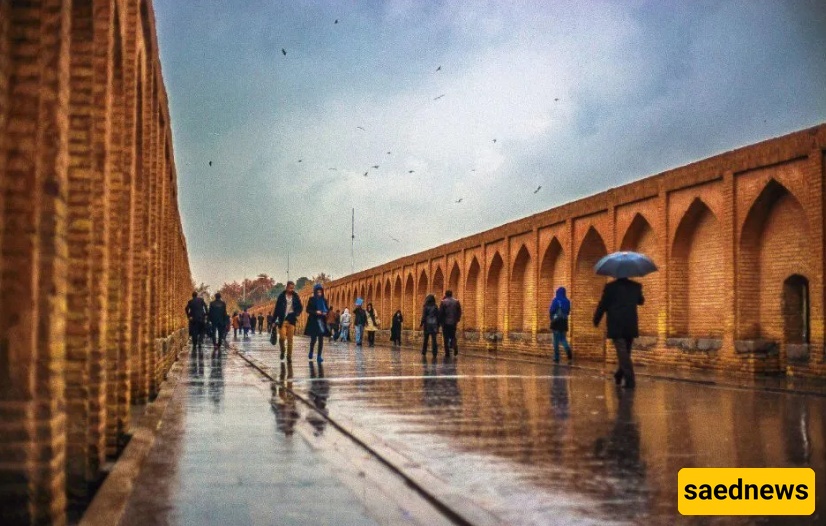

When one thinks of water and rivers, the image that comes to mind is often the reflection of the sky on the earth. However, in recent years, the skies of Isfahan have been deprived of seeing their own reflection in the waters of the Zayandeh Rud River for long periods, perhaps even forgetting their own image above this city. In the past, water used to flow through the Zayandeh Rud, passing under the Thirty-Three Arches Bridge, bringing life to the city.
During the times when the river flowed, people would ride boats and admire the beauty of the bridge from a different perspective. But when the water disappears, the Thirty-Three Arches Bridge takes on a sorrowful aspect, filled with the painful wounds that worsen day by day. People come to this bridge even during dry days, yet their eyes carry a longing for the sweet days whose return they hope for but cannot be sure of.
Indeed, in 2019 (1398 Iranian calendar), the Zayandeh Rud River returned to flow and surge as usual, but who knows how long this situation will last? Will the water come back only occasionally, just enough to remind historic bridges in Isfahan, like the Thirty-Three Arches Bridge, of their beauty reflected in the water? Can we ever return to the enduring clarity and serenity that once was?
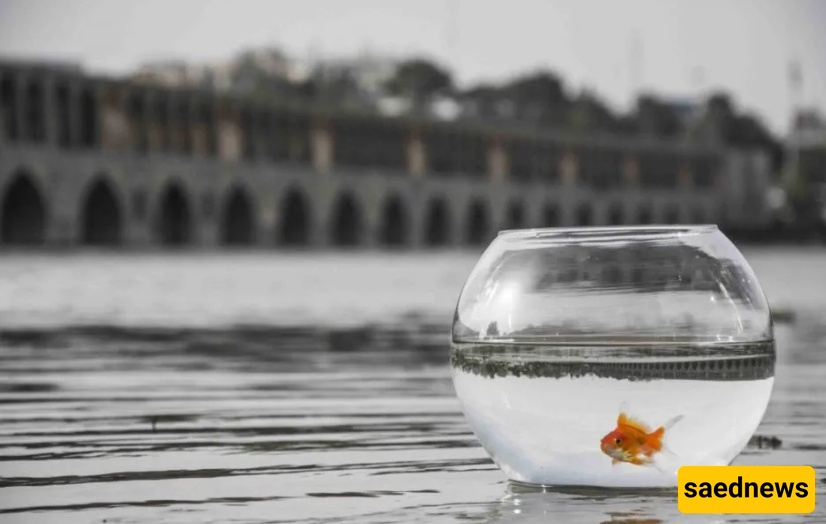
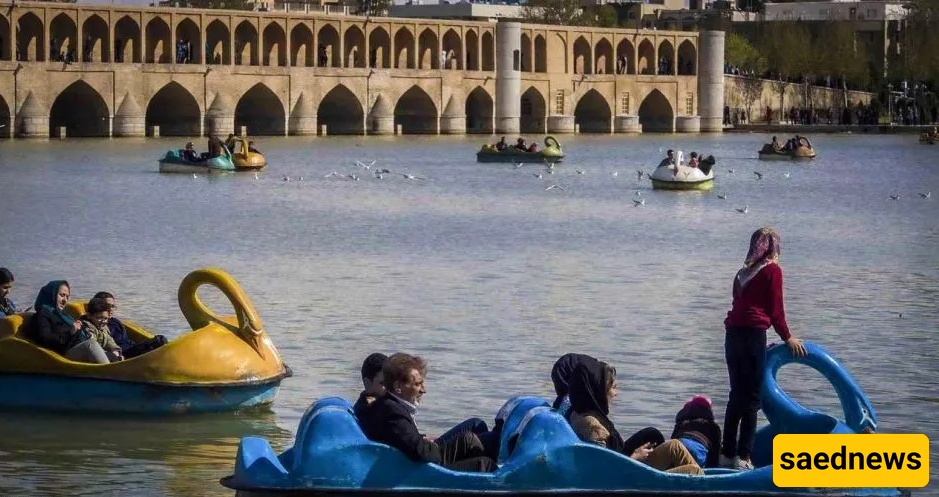
Isfahan is regarded as one of the favorite tourist destinations for international visitors, and the "Thirty-Three Arches Bridge" (Si-o-se Pol) is considered a must-see landmark. Below is a selection of tourists’ reviews from the website "TripAdvisor":
Greek Tourist | Visit Date: May 2019
This place is not just a bridge; it is a gathering spot where people come together. The bridge is named "Thirty-Three Arches" because it has thirty-three arches spanning the Zayandeh Rud River. Built in the 20th century, it is about 300 meters long, making it the longest bridge in the city. The bridge is a symbol of Isfahan and a remarkable example of bridges constructed during the Safavid era. Visiting this bridge is a unique experience, especially at night when the lights illuminate the bridge and people gather for picnics under the starry sky.
Singaporean Tourist | Visit Date: May 2019
A wonderful bridge, especially at night. If you visit Isfahan, you must walk across this bridge. Many local residents come here for picnics. The atmosphere around the bridge is peaceful, and the place becomes magical at sunset. When the lights turn on at night, the bridge reaches the peak of its beauty.
New Zealand Tourist | Visit Date: April 2019
Amazing! I was lucky enough to visit the bridge when the river was full of water; at that time, the bridge looked absolutely stunning. My first visit was in the afternoon, but I returned at sunset to see it at its best. This bridge must be seen both during the day and at night, especially since it features attractive night lighting.
Dutch Tourist | Visit Date: April 2019
Beautiful. The bridge is beautiful even when the river is dry. Usually, many people are present on and around the bridge.
Turkish Tourist | Visit Date: April 2019
Amazing! We visited the bridge both during the day and at night. I can say the night view was more beautiful. It is a fantastic place for photography.
